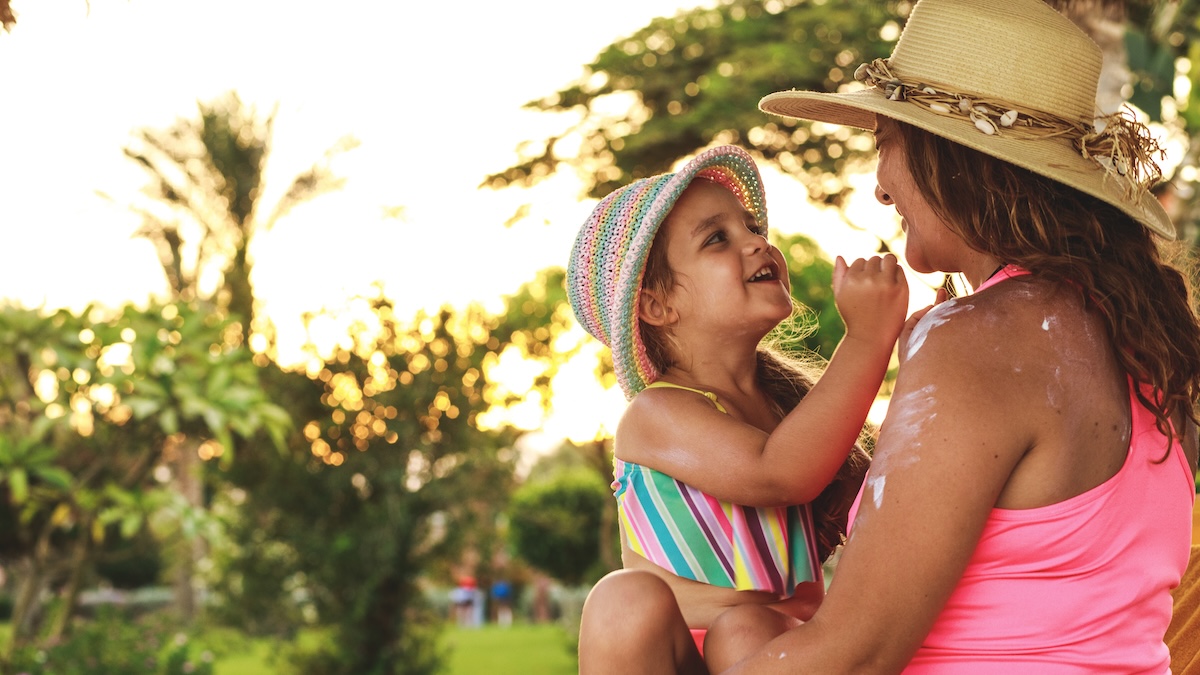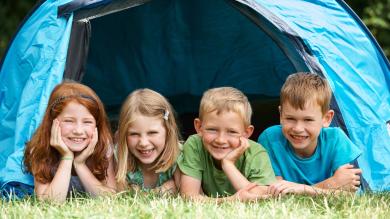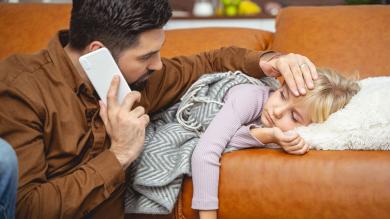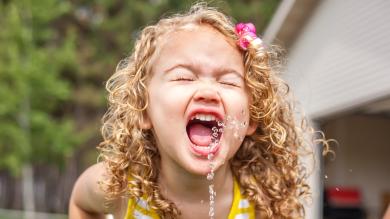
Protect children from sun and heat
Every summer brings new heat records, and we will have to deal with the challenges of unusually high temperatures more and more frequently in the future. This makes heat and sun protection all the more important - especially for the little ones.
The German Weather Service (DWD) provides detailed information on the weather and climate.
Tips for hot days
The younger children are, the more they need to be protected from heat, as the body's own protection against high temperatures is not yet fully developed in babies and toddlers.
Unlike adults, who are able to cool down by sweating and adapt better to higher temperatures, children are not yet able to sweat to the same extent and are more likely to dehydrate. This is why they suffer more quickly from the heat and need special protection from parents or caregivers .
Sunburn, sunstroke, heatstroke: recognizing symptoms and taking action
High temperatures pose a particular risk for children. To protect them from sunburn, sunstroke and heatstroke, it is important to know the symptoms and take appropriate measures.
What to do in case of sunburn?
Symptoms of sunburn:
- Skin is red, itchy or burns
- Skin feels hot, hurts or swells up
- Skin tightens and is sensitive to touch
If blisters appear, this is a burn and should be treated by a doctor. Medical treatment is also important for nausea and circulatory problems.
Measures for sunburn:
- Get out of the sun and into the shade immediately
- Cool with compresses that are not too cold. No cool packs from the freezer (!), these can further damage the skin
- Apply moisturizing lotions or creams (check for intolerances)
- Avoid friction on the affected skin areas (preferably air contact)
- Drink a lot
What to do in case of sunstroke?
Symptoms of sunstroke:
- Hot, red head with normal skin and body temperature
- Restlessness and confusion
- Headaches, dizziness or ringing in the ears
- Circulatory problems up to and including unconsciousness
- Vomiting
- Stiff neck
Measures for sunstroke:
- Seek out shade
- Lie down quietly and keep your head elevated
- Cool head and neck with damp, lukewarm cloths, but do not overcool
What to do in case of heat stroke?
Heat stroke affects the whole body. The body is then no longer able to regulate its temperature by sweating. This is typically the case in warm, humid weather.
Symptoms of heat stroke:
- Red head, reddened, hot and dry skin, which later turns grayish or bluish
- Very high body temperature
- Unsteady gait, dull facial expression
- Headache
- Rapid and shallow breathing and possible loss of consciousness
Heat stroke is a medical emergency and must be treated by emergency doctors or in an emergency room.
Measures for heat stroke:
- Seek out shade
- Lay the affected person down quietly and put their legs up
- Remove tight clothing
- Cool, but do not overcool
- Provide fluids if the person concerned is conscious
- Initiate first aid measures
What is the best way to protect ourselves on hot days?
Even if the sun invites you to sunbathe, it is important to avoid the direct midday sun, especially on hot days, and to seek out cool shady spots instead. Make sure you drink enough (not too cold) water or unsweetened drinks to keep yourself hydrated and cool down .
What to wear in hot weather?
- A sun hat or cap to protect your head and neck from the sun. A hat with neck protection is recommended for children
- A long-sleeved, tightly woven, loose-fitting shirt (preferably made from a breathable fabric) to protect your arms from direct sunlight
- Long pants or skirts help to cover the legs
- Closed shoes offer protection for the feet, including the back of the foot and heels
All uncovered parts of the body should be protected with a suitable sunscreen should be applied. The higher the sun protection factor, the better. Regular reapplication is important to maintain protection throughout the day.
Children imitate their adult role models. In order for children to learn to protect themselves responsibly from the risks of the sun, it is important that we adults also wear protective clothing, apply sunscreen regularly and avoid intense sunlight.
Sun protection for babies and toddlers under two years of age
Children under the age of two should never be exposed to direct sunlight, as their body's own UV protection is not yet sufficiently developed. Even with sun protection such as an umbrella or awning, the blazing sun should be avoided. There is a risk of children overheating.
In addition, children under the age of two should remain fully clothed in thin, airy clothing even in the shade (as described in the previous paragraph).
As a general rule, the younger the child, the more stringent the sun protection should be.
How to keep rooms cool in the heat?
There are a few simple measures you can take to reduce the heat in your own home on hot days:
- Close windows and blinds during the day to keep the heat out
- Open windows early in the morning and in the evening to let in fresh, cooler air
- Switch off electronic devices if possible, as they generate additional heat
- Place wet towels in front of the windows to draw heat out of the air
5 activities for children on hot days
1. water games in the garden or on the balcony: Children can have fun, splash around and cool off with a paddling pool or water bombs in the garden. If you're looking for great swimming fun, you'll find it in the outdoor pool or at the lake. It is important to reapply sunscreen regularly.
2. make your own ice cream: Ice cream or water ice is quick to make with simple ingredients such as yogurt and fruit - a creative and refreshing activity on hot days.
3. evening walks: An evening walk before going to bed helps to get rid of excess energy. This can become part of the bedtime ritual so that everyone can fall into bed exhausted.
4th trip to the forest: In the shady forest, children can play protected from the sun and explore nature. Important: Even in the shade, they need the additional protection of a suitable sunscreen - and don't forget to check the children for tick bites after the day in the forest.
5. visit a museum or movie theater: A trip to an air-conditioned museum or movie theater is a great way to stay cool on a hot day, discover new things and spend time together.
Heat protection in our childcare centers
In our pme Learning Worlds facilities, particular attention is paid to protecting children and team members from excessive temperatures. High temperatures can pose a safety risk, especially in closed rooms.
For this reason, we regularly discuss the topic of heat protection in team meetings and parent-teacher conferences and inform parents about upcoming heat waves .
On hot days, the educational staff in our childcare centers pay particular attention to this:
- Keep rooms, especially bedrooms, cool, ventilate in the morning and darken windows if necessary
- Go to cool places, stay in the shade of the outdoor area or plan walks in the forest
- Provide unsweetened drinks for everyone, remind children to drink more often and provide light food
- In very hot weather (from around 27 degrees Celsius), allow quiet play and offer paddling pools or water games
- Recognize heat-related complaints in children and team members and initiate first aid measures if necessary











